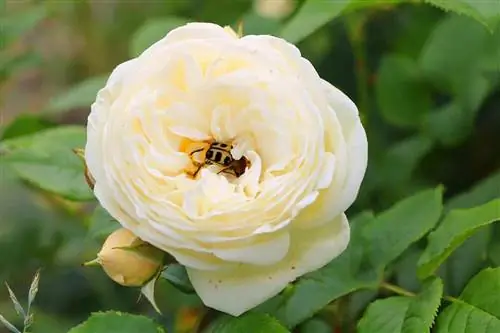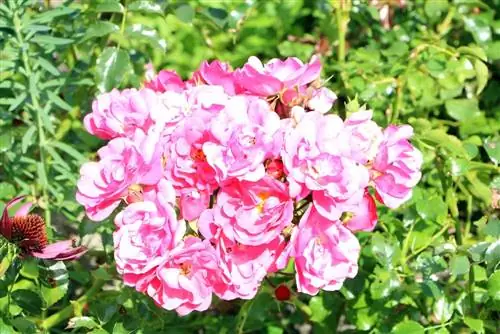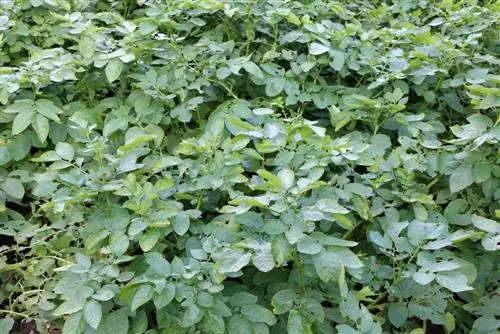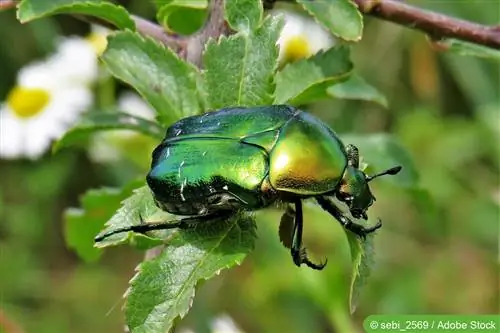- Author admin [email protected].
- Public 2023-12-17 03:39.
- Last modified 2025-01-24 12:45.
Of course, today there is a suitable chemical remedy for almost every infestation with vermin or every harmful problem, no matter how unusual. But in the vast majority of cases this is not necessary. If you identify pests quickly and take countermeasures at an early stage, proven home remedies that are completely safe for the other flora and fauna in your own garden are sufficient in most cases.
Aphidoidea
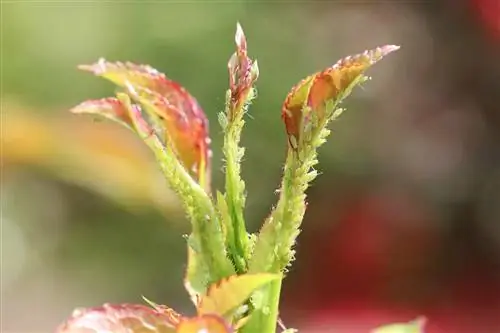
Origin: Insects, belonging to the plant lice
Distinguishing features:
- Oval, elongated body shape
- Greenish to brownish coloring
- Body length by 1 to 3 millimeters
- Mostly located on stems and undersides of leaves
- “Honeydew”, drop-like excretions of lice
Cause of damage: Plant tracks bitten to get to the plant sap
Damage:
- Brown dots and spots
- Drying leaves, shoots and buds
- Withering and death of plants or parts of plants
Remedy:
- Spray with a solution of 50 grams of soft soap to one liter of water
- Settlement of parasitic wasps or ladybirds as predators of aphids
ATTENTION:
Like spider mites, aphids are hardly host-specific and attack a variety of plants in the garden. That's why they are no less dangerous as pests for the rose family and should be actively addressed!
Common rose beetle (Cetonia aurata)
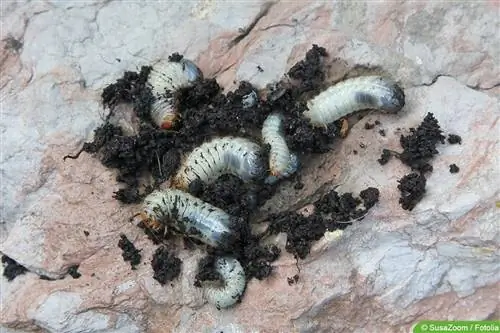
Synonym: Gold Beetle
Origin: Scarab beetle family
Distinguishing features:
- Body length 14 to 20 millimeters
- Green to copper-colored shiny shell
- Mostly golden yellow color gradient in the area of the dorsal shield
Cause of damage: Eating flowers and young shoots
Damage:
- Falling buds and flowers
- Dying shoots
- Lower growth and development performance on damaged plant parts
- General weakening of the plant
Remedy: Collecting and relocating the beetles
ATTENTION:
Even if these beetles appear again and again in large numbers and cause enormous damage, they must not be killed by household remedies or chemical preparations. The community rose beetle is a protected species and was even beetle of the year in 2000. Although it is protected, it is only an endangered species in a few areas.
Rose leaf leaf miner (Gracillariidae)
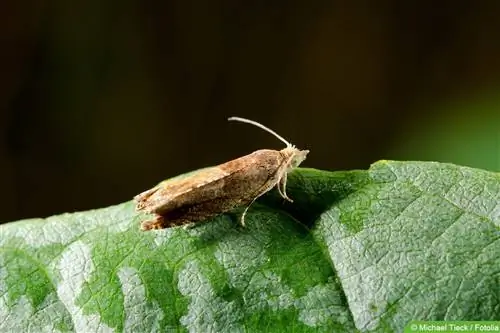
Origin: Butterflies
Distinguishing features:
- Slender brown-spotted moth
- Body length by 10 to 15 millimeters
- Larval infestation can be recognized by lines on the leaves, otherwise hardly noticeable because they are inside the leaves
Cause of damage: Feeding passages in the leaf tissue, visible as light lines on the leaf surfaces
Damage:
- Dying leaves
- Overall, mostly only minor infestation, therefore hardly any relevant damage pattern
Remedy: As a rule, no remedy or countermeasure is required
Rose leafhopper (Edwardsiana rosae)
Origin: Insects
Distinguishing features:
- Pale green to yellow-green body color
- Elongated, slim physique
- Body length 3 to 4 millimeters
- Pronounced rear pair of legs
- Larvae creamy white to green and flightless
- Occur mainly from the end of May to mid-July and from the end of August to September (egg-laying times)
Cause of damage:
- Damage caused by larvae
- Laying eggs in the shoots
Damage:
- Weakening of the plant
- Brown spots and spots on leaves
- Striving leaves and young shoots
Remedy:
- Prevention through cooler, well-ventilated location
- Scare away the animals by shaking the shoots (cicadas jump away)
- Otherwise no effective home remedies known
Rosselleaf roller wasp (Blennocampa pusilla)
Origin: Sawfly family
Distinguishing features:
- Caterpillars 5-9 millimeters long, green coloring
- Wasps 3 to 4 millimeters long, black body color with clear wings
Cause of damage:
- Rolling up the leaves as a protective plant cocoon for the larvae during development, period May to early June
- Rolls triggered by bitten leaf veins
Damage: No blatant damage, occasionally slight weakening due to intensive leaf fall
Remedy:
- No home remedies known
- Usually no countermeasure is necessary
NOTE:
In addition to the rose leaf sawfly, there are other sawfly representatives that use rose bushes as breeding grounds. In cases of excessive infestation, the caterpillars can usually be easily removed without requiring further control methods.
Rose sawfly (Caliroa aethiops)
Origin: species from the sawfly family that specializes in roses
Distinguishing features:
- adult animals black with gray wings
- approx. 5 millimeters body length
- Larvae (actual cause of damage) up to 1 centimeter long, light green upper side, yellow underside, body shape similar to slugs
- Mostly occur in March and again in July (egg-laying time)
Cause of damage: Leaf feeding by the larvae
Damage:
- Initially punctual feeding areas, later leaf skeletons eaten away down to the leaf veins
- Dying shoots
- General weakening of the plant up to death due to a lack of photosynthesis without leaves
Remedy
- No prevention possible
- Collecting the larvae
- Repeated spraying with manure made from oak leaves and bark and water
Rose shoot borer (Blennocampa elongatula, Ardis brunniventris)
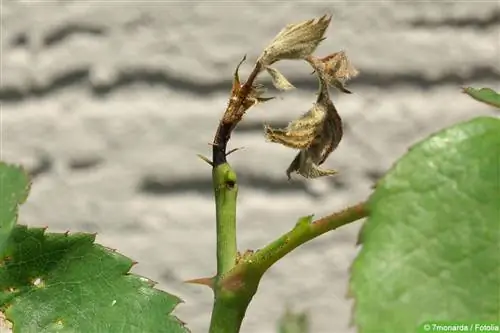
Origin: Larva later actually for the rose of uncritical sawfly species
Identifying features: White, slender caterpillars with brown head capsule
Cause of damage: Feeding passages in the young shoots, with the “ascending rose shoot borer” leading from the bottom towards the tip of the leaf, with the “descending rose shoot borer” leading from top to bottom
Damage:
- Weakening of shoots and plants
- when drills stiffen, the terminal bud dies off
- In case of intensive infestation, shoots or even plants die off
Remedy:
- mechanical killing of the larvae by inserting a wire into the feeding channels
- Pruning of affected shoots below the feeding ducts
Rose moth (Notoceliaea)
Origin:Family of butterflies
Distinguishing features:
- Adult animals spotted beige-brown, body length around 15 to 20 millimeters
- Caterpillars thin and green colored
Cause of damage:
- Laying eggs in the young shoots of rose bushes
- Damage caused by adult animals
Damage:
- Dying young shoots
- Falling flowers and leaves
- Weakening of the plant
Remedy:
- Collecting small quantities of caterpillars
- Cutting off and disposing of affected shoots
- Repeated spraying of the caterpillars with rapeseed oil
Spider mites (Tetranychus urticae)
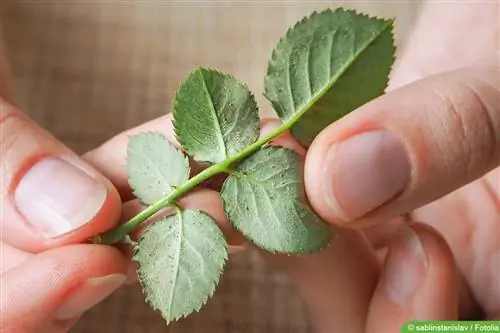
Origin: Spider mite family with around 1,300 subspecies, especially the “common spider mite”
Distinguishing features:
- round to oval abdomen and glassy, partly darkly spotted coloring, significantly larger than the stocky forebody
- Height around 0.3 to 0.6 millimeters
- Easily visible white, flat webs on the undersides of the leaves of the plants
Cause of damage: Bitten plant fibers for nutrition through plant sap
Damage:
- Initially yellow, later brown spots on the leaves (develop from the bite marks)
- Later drying of leaves and death of shoots
Remedy:
- Prevention through an airy, moist location, ideally exposed to the rain and not too hot
- Kill spider mites with an emulsion of 250 milliliters of rapeseed oil to one liter of water, mix well and spray repeatedly
- Rain plants repeatedly and vigorously
- Boil the broth of onions or garlic, let it cool and spray the plants repeatedly
Greenhouse scale insect (Trialeurodes vaporariorum)
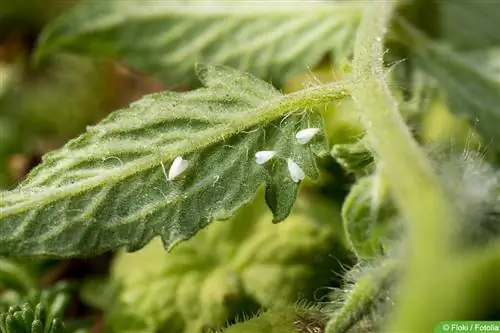
Synonym: Whiteflies
Origin: Insects
Distinguishing features:
- Slender whiteflies, only around one to two millimeters in size, with an elongated body shape
- Retired “Honeydew”
- whiteflies visible as white dots on the undersides of the leaves
- Soaring swarms when the roses move
Cause of damage: Bitten plant cells for nutrition via the plant sap
Damage:
- Black dots on the underside of the leaves
- Frequent leaf shedding
- Weakening of the affected shoots
Remedy:
- Rapeseed oil-water mixtures for repeated spraying
- Soap solution for repeated use on the undersides of the leaves
- Prevention through well-ventilated locations
NOTE:
Beyond the damage described in each case, any infestation with vermin means an increased risk of infection by pathogens or fungi. Bite marks, egg laying or other impairments represent weak points in the plant's protective shell. The effects of this secondary infestation are often far more serious than those caused by the pest itself. Therefore, you should control rose pests in most cases, even if the direct impact is small.

